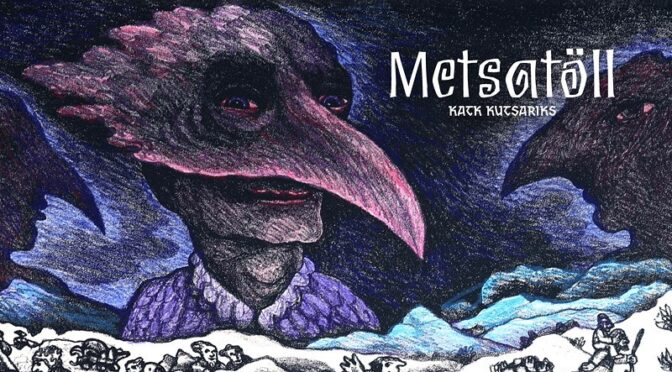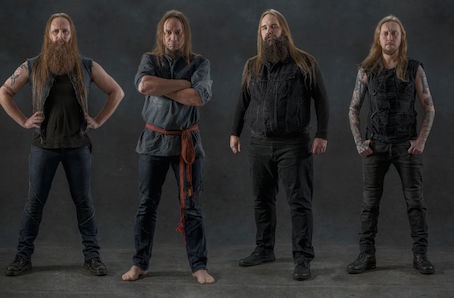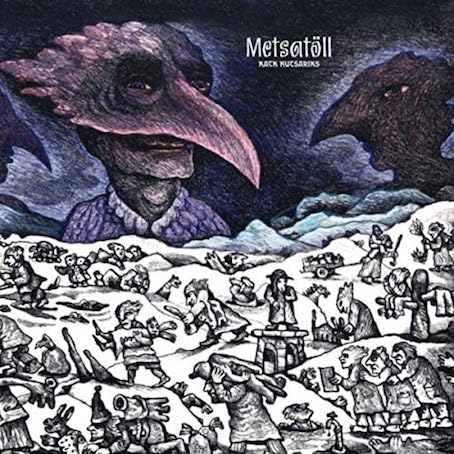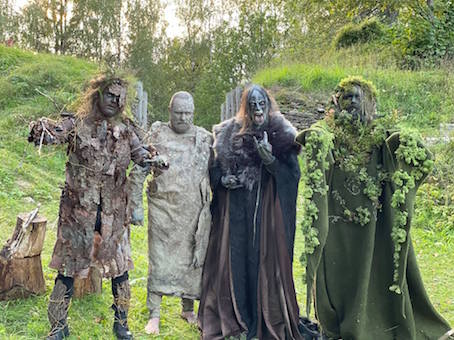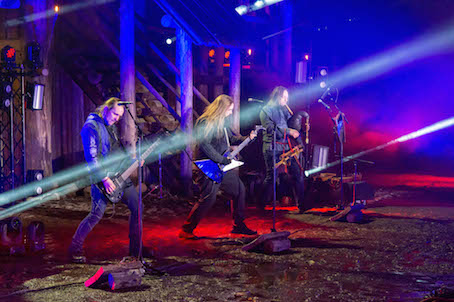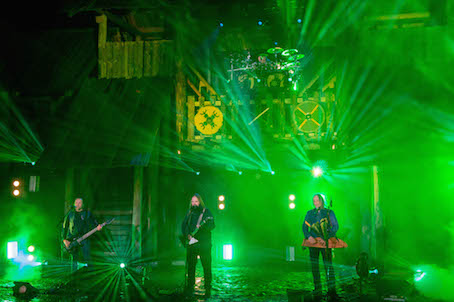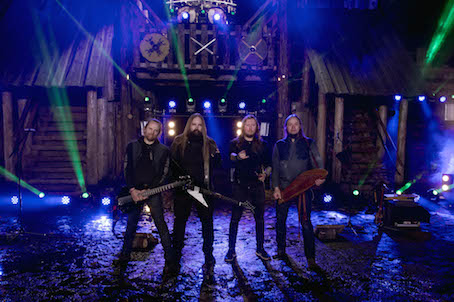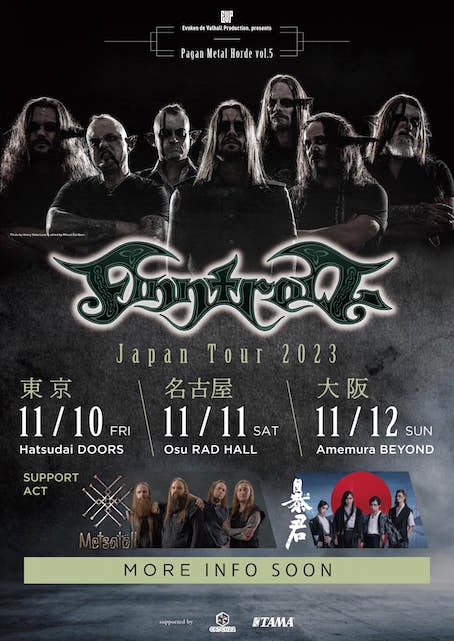EXCLUSIVE: INTERVIEW WITH LAURI OUNAPUU OF Metsatöll !!
“By Respecting Our Own Culture, We Also Learn To Respect The Stranger, Even If We Cannot Agree With Them And Don’t Share The Same Values.”
DISC REVIEW “Katk kutsariks”
「私はあらゆる文化に敬意を抱いている。特に、自分たちのルーツや先祖に誇りを持ち、自分たちの民族文化に偽りの羞恥心を抱くことなく、あえて自分たちらしくいようとする人々には敬意を抱いている。過激な民族運動に見られるような民族中心主義や、人種中心主義について言っているのではない。自国の文化を尊重することで、たとえ意見が合わなかったり、同じ価値観を共有できなかったりしても、見知らぬ人を尊重することを学ぶのだ」
例えば、私たちはヘヴィ・メタルを愛しているからこそ、メタル以外の音楽も尊重し、リスペクトすることができるのかもしれません。それは、ジャンルこそ違えど、音楽やその文化を愛することがいかに尊く、純粋であるかを知っているから。それはきっと、国籍や人種、宗教においても同じなのではないでしょうか?自らのルーツを愛し、ルーツの尊さを知るからこそ、他者のルーツを尊重できる。自国は常に “正義” で、他国は “悪” なのでしょうか? そんなはずはないでしょう? 他者やそのルーツに対する “寛容さ” があまりにも必要とされている現代社会において、フォーク・メタルは、自身はもちろん、他者の文化や民族を尊重するための完璧なツールなのかも知れませんね。
「エストニア人も日本人も、多くの同じものを見ていることは確かだ。小国に対する西洋文化の圧力がますます強まっているにもかかわらず、私たちの文化にはかなり古い世界観が残されていて、それは “非二元的” な世界観に反映されている。すべては観察者の視点と現象の解釈次第であり、その本質は果てしない否定主義や肯定主義に囚われることなく、ヒーローもアンチヒーローもなく、完全な善も悪も、白も黒もない。非二元的な世界観、伝統や神話を愛し、物語を語ることは、間違いなくエストニアと日本の文化を結びつけるものだよ」
そもそも、江戸時代、日本で “勧善懲悪” が好まれるようになったのは、幕府が物事を単純化して人民を統治しやすくためだったという説もありますが、たしかに古事記を紐解けばイザナキとイザナミの兄妹婚や神なのにやたらと人間臭いスサノヲノミコト、コノハナサクヤビメの一夜孕みなど、タブーを積極的に扱うことで、世界は白か黒か、善か悪かに単純には割り切れないことを示していたような節があります。そして、世界中の神話の中には、そうしてタブーを扱った話が決して少なくはないのです。エストニアの伝承や神話、伝統音楽をメタルに結んだ Metsatöll は、かくしてフォーク・メタルを哲学していきます。
「ここでいうフォーク・メタルとは民族の音楽言語を使うフォーク・メタルで、民族楽器、民謡、母語を使う。中世的なロマンチックな衣装を身にまとい、ギター・リフの合間に映画音楽にインスパイアされたメロディーを奏でる “フォーク・メタル” もクールで良い音楽であることは間違いないが、あれはただのメタル・ミュージックだ。 自分の民族のルーツが何なのか、先祖の文化や音楽が何だったのかを知ることは重要だ。ルーツにはすごい力がある。少なくとも私にとっては、民族楽器を演奏するときに重要なのは、その楽器を演奏することだけでなく、その楽器の歴史、その楽器の音色、歴史的にどのように演奏されてきたのか、そしてその楽器がおそらくどこから来たのかを知ることだと思う」
フォーク・メタルの哲学者、森の賢人 “狼” の異名を持つ Metsatöll は、90年代から活動を続け、シーンの酸いも甘いも噛み締めてきた歴戦の勇者。だからこそ、BLOODYWOOD や THE HU の大ブレイクで活気付くフォーク・メタルの台頭にも、一つの願いを覗かせます。それはルーツを愛すること。ルーツを愛し、文化を愛し、歴史を愛し、言語を愛した真の “フォーク・メタル” だからこそ、強く、寛容になれる。
エストニアは、長年の占領と抑圧、ソ連崩壊とそれに続くグローバリゼーション、資本主義、物質主義がもたらした価値観の変化によって引き起こされた文化的トラウマを抱えてそれでも、ITや学問の分野で台頭し、力強く生き延びてきました。強いだけでも、優しいだけでもない、非二元論の “誇り” が彼らを支えたとすれば、Metsatöll の音楽にはまさしくその誇りが見事に宿っています。呪術的で重苦しく、リズムの迷宮にあって、しかしどこか牧歌的で、歌える生命力にみちた秘宝。それはきっと、”側” だけをドラマティックに仕立てた偽のフォーク・メタルにはないものなのかもしれませんね。
今回弊誌では、Lauri “Varulven” Õunapuu にインタビューを行うことができました。「私はスタジオジブリ、特に宮崎駿の作品に感銘を受けてきた。”猫の恩返し”、”千と千尋の神隠し”、”紅の豚” が子供向けか大人向けかは議論の余地があるが、彼らが扱うテーマや世界を反映する方法は時代を超越していて、典型的なハリウッドの世界よりも人間の本質をより明確に表現していることは間違いない。芸術は問いを投げかけ、問いは人々に考えさせるものでなければならない」エストニア大統領にも賞賛させる国民的バンドの来日が決定。どうぞ!!
Metsatöll “Katk kutsariks” : 10/10
INTERVIEW WITH LAURI OUNAPUU
Q1: You have decided to come to Japan for the first time! You guys sometimes use animated stuff in your artwork and videos. First of all, please tell us about Japan and your impressions of Japanese anime and game culture.
【LAURI】: It is indeed a great honour to travel to our first concerts in Japan, we have tried many times before to find contacts and opportunities to perform in the Land of the Rising Sun, it has not been easy for the Estonian band, after all, Japan is quite far from us. Both physically and certainly culturally. Although it must be said that we humans here and there certainly see many things in the same way, both Estonians and Japanese. Regardless of the ever-increasing pressure of a Western culture on small nations, we have preserved a rather ancient worldview in the culture of our people, which is reflected in a non-dual worldview. Everything depends on the perspective of the observer and the interpretation of phenomena, the essence of which is not stuck in endless negativism or positivism, there are no heroes and anti-heroes, completely good or bad. This worldview is also in the art of the Estonian artist Jüri Arrak, with whom we have had the honor to collaborate. You can find Arrak’s art and animations on Metsatöll’s albums and videos. To the sadness of all of us, Jüri Arrak is no longer with us, he passed away a year ago.
It is fascinating that the same kind of non-dual world view can be observed also in Japanese animation, I am of course not talking about everything that concerns Japanese-like expressions, probably more about what I myself have experienced and what I have managed to observe. Of course, I have been impressed by Studio Ghibli and especially Hayao Miyazaki’s work, it can be argued whether “Neko no ongaeshi”, “Sen to Chihiro no kamikakushi” or “Kurenai no buta” are intended for children or adults, but the topics they deal with and how they reflect the world is timeless and certainly expresses the human nature more clearly than the typical Hollywood world. Art must raise questions, and questions make people think. This is one of the basic principles of human nature, when we stop analyzing and thinking, even about the meaning of life and human nature, we stop being a part of the world. However, if we detach ourselves from reality and the world itself, will the world still be able to accept us and maybe even tolerate us. By turning into a cancer-tumor of the planet, we cannot be sure of that.
A non-dual world view, love of traditions and myths, telling stories is definitely something that unites Estonian and Japanese culture.
Maybe it’s changing, I can’t comment on it because I don’t have a TV, I don’t know what’s shown and what’s being watched. I also don’t spend my days playing computer games, maybe everything is different there and the narratives that are told are already different. How I see the transmission of cultures over time is that each nation and tribe has primordial features and knowledge, which have become like the root-texts of one nation, something that has been learned and heard from one’s parents, grandparents, etc. These texts from the primeval times still influence the culture of the people, we see the world from the same perspective as our predecessors, but during the triumph of mass communication, this is changing, we copy and imitate also cultures that are a mouse-click away, but are unfamiliar and alien. In the global world, non-habituation becomes habituation, little by little we lose our own face. However, there is a counter-movement in folk cultures, a counter-reaction of the people themselves, we are looking for our roots and true self, it is good if it is preserved and does not lose its relevance in today’s culture. Metsatöll is one of those milestones in the Estonian resistance movement in the global soup pot.
Q1: 初来日が決まりましたね!あなたたちはアートワークや映像にアニメーションを使うことがありますが、まずは日本について、そして日本のアニメやゲーム文化についての印象を聞かせてください。
【LAURI】: これまで何度も、日出ずる国で演奏するために連絡先や機会を見つけようと試みてきたけど、エストニアのバンドにとってそれは簡単なことではなかったんだ。物理的にも、文化的にも。
とはいえ、エストニア人も日本人も、多くの同じものを見ていることは確かだ。小国に対する西洋文化の圧力がますます強まっているにもかかわらず、私たちの文化にはかなり古い世界観が残されていて、それは “非二元的” な世界観に反映されている。すべては観察者の視点と現象の解釈次第であり、その本質は果てしない否定主義や肯定主義に囚われることなく、ヒーローもアンチヒーローもなく、完全な善も悪も、白も黒もない。このような世界観は、私たちがコラボレーションしたエストニアのアーティスト Jüri Arrak のアートにもある。Arrak のアートやアニメーションは、Metsatöll のアルバムやビデオで見ることができるよ。残念なことに、彼は1年前に他界してしまったがね。
同じような非二元的な世界観が、日本のアニメーションにも見られるのは魅力的だ。もちろん、日本的な表現にまつわるすべてについて話しているのではなく、私自身が経験し、観察することができたことについて話しているのだがね。もちろん、私はスタジオジブリ、特に宮崎駿の作品に感銘を受けてきた。”猫の恩返し”、”千と千尋の神隠し”、”紅の豚” が子供向けか大人向けかは議論の余地があるが、彼らが扱うテーマや世界を反映する方法は時代を超越していて、典型的なハリウッドの世界よりも人間の本質をより明確に表現していることは間違いない。
芸術は問いを投げかけ、問いは人々に考えさせるものでなければならない。これは人間性の基本原則のひとつであり、人生の意味や人間の本質についてでさえ、分析したり考えたりすることをやめたとき、私たちは世界の一部であることをやめてしまう。しかし、もし私たちが現実や世界そのものから自分を切り離したとしても、世界は私たちを受け入れることができるだろうか。地球の癌腫瘍と化すことで、私たちはそれを確信することはできない。非二元的な世界観、伝統や神話を愛し、物語を語ることは、間違いなくエストニアと日本の文化を結びつけるものだよ。
私はテレビを持っていないので、何が放映され、何が見られているのか知らない。また、コンピューターゲームに明け暮れることもない。もしかしたら、そこではすべてが違っていて、語られる物語もすでに違っているのかもしれない。私が考える文化の継承とは、それぞれの国や部族が原初的な特徴や知識を持っていて、それがひとつの国の根源的なテキストのようになり、両親や祖父母などから学んだり聞いたりしてきたものだということだ。これらの原始時代からのテキストは、今でも人々の文化に影響を与え、私たちは先人たちと同じ視点から世界を見ている。
しかし、マス・コミュニケーションの勝利の間に、この状況は変わりつつあり、私たちは、マウスをクリックするだけでアクセスできる、馴染みのない異質な文化もコピーし、模倣している。グローバルな世界では、慣れとなり、私たちは少しずつ自分の顔を失っていく。自分たちのルーツや真の自己を探し求め、それが保存され、今日の文化との関連性を失わないのであれば、それに越したことはないのだがね。Metsatöll は、世界的な鍋の中のエストニアの抵抗運動における、そのような一里塚のひとつである。
Q2: You guys sing about Estonian folklore and traditions, but Japan also has a long history and various myths. Do you feel any sympathy for Japan?
【LAURI】: I have respect for all cultures, especially those who dare to be themselves without feeling false shame about their folk culture, who are proud of their roots and ancestors. I am not talking about the ethnocentrism that we can sometimes find in extremist national-movements, nor the racial centrism. By respecting our own culture, we also learn to respect the stranger, even if we cannot agree with them and don’t share the same values.
What also unites the traditional world view of Japan and Estonia, as I see it, is respect for your opponent, even if fate has taken you to different sides in the fight, there is no reason to think that the opponent does not deserve respect after death.
This is reflected in the Estonian traditional peasant culture in the same way, perhaps you have noticed something similar in Japan – if a person hunts or keeps animals, uses their meat, milk, labor, then the peasant treats these animals in the same way as his own equal, although apparently, as per the 21st century worldview, the person would be an imaginary at the top of the pyramid of exploitation, traditional peasant wisdom still points to the fact that we are and will remain just a tiny cog in the throbbing-steaming world machine.
Q2: あなたたちはエストニアの伝承や伝統、歴史を歌にしていますが、日本にも長い歴史や様々な神話があって、そういう意味で共感する部分もあるのではないですか?
【LAURI】: 私はあらゆる文化に敬意を抱いている。特に、自分たちのルーツや先祖に誇りを持ち、自分たちの民族文化に偽りの羞恥心を抱くことなく、あえて自分たちらしくいようとする人々には敬意を抱いている。過激な民族運動に見られるような民族中心主義や、人種中心主義について言っているのではない。自国の文化を尊重することで、たとえ意見が合わなかったり、同じ価値観を共有できなかったりしても、見知らぬ人を尊重することを学ぶのだ。
私が思うに、日本とエストニアの伝統的な世界観を結びつけるものもまた、相手に対する敬意だろう。たとえ運命に翻弄され、戦いの中で異なる側についたとしても、死後、相手が敬意に値しないと考える理由はない。
このことは、エストニアの伝統的な農民文化にも同じように反映されている。おそらく、日本でも似たようなことに気づくのではないか。ある人が動物を狩ったり飼ったりして、その肉や乳や労働力を利用する場合、農民はこれらの動物を自分と同等に扱う。どうやら21世紀の世界観に従えば、人は搾取のピラミッドの頂点に立つ想像上の存在になるようだが、伝統的な農民の知恵では依然として、私たちはどろどろと蒸し上がる世界の機械の小さな歯車に過ぎず、これからもそうあり続けるという事実を指し示しているんだよ。
Q3: It is difficult to imagine hard rock and metal music in Estonia, but can you tell us how you got into such music in such a place? What is the Estonian hard rock and metal scene actually like?
【LAURI】: I can say that looking at the world from here in tiny Estonia, it is equally difficult to imagine Japanese bands and what they could sing about or what kind of music they could play! The only solution to dispel such fog is to see with your own eyes and listen with your own ears what is actually being done over there on the other side of the world.
As you can imagine, just like in any band, Metsatöll, even though there are only four of us, are people with very different worldviews, different musical backgrounds, and different preferences. What unites us is respect for Estonian culture, -language and metal. So, putting all this together, it makes perfect sense that our songs are in Estonian languages (we write texts in the dialects of different Estonian localities, we use archaisms and language layers from different eras), woven through Estonian history, and of course metal.
In general, however, Estonian music is quite the same as in other parts of the world, it especially concerns both rock and metal genres. We cannot get over or around the world’s music trends, but there are also quite original, let’s say, Estonian-ish bands and musicians with a unique musical-language. In the last decade, Estonian folk music has become very relevant again, so there have been quite a few bands that use Estonian folk songs, folk instruments and want to reflect Estonian culture.
Q3: エストニアのメタルやロックと聞いてパッと想像するのはなかなか難しいのですが、そうした場所でメタルにハマっていったきっかけを教えてください。
【LAURI】: 逆に、ここ小さなエストニアから世界を眺めたところで、日本のバンドが何を歌い、どんな音楽を奏でるのかを想像するのは難しい!そんな霧を晴らす唯一の解決策は、地球の裏側で実際に何が行われているかを自分の目で見て、自分の耳で聴くことなんだ。
ご想像の通り、どのバンドでもそうであるように、Metsatöll はたった4人とはいえ、まったく異なる世界観、異なる音楽的背景、異なる嗜好を持つ人々だ。私たちを結びつけているのは、エストニアの文化、言語、そしてメタルに対する敬意なんだよ。だから、私たちの楽曲がエストニア語で書かれ(エストニアのさまざまな地方の方言で文章を書き、さまざまな時代の古語や言葉のレイヤーを使っている)、エストニアの歴史が織り込まれ、そしてもちろんメタルであることは、これらすべてをまとめると完全に理にかなっている。
しかし一般的に、エストニアの音楽は世界の他の地域とまったく同じで、特にロックとメタルの両方のジャンルに近いね。ただ、私たちは世界の音楽トレンドに流されることはないし、エストニア独自の、言ってみれば独自の音楽言語を持つバンドやミュージシャンもここには存在する。ここ10年、エストニアの民族音楽は再び重要性を増していて、エストニア民謡や民族楽器を使い、エストニア文化を反映させようとするバンドがかなり出てきているんだ。
Q4: Why did you decide to combine Estonian folk music with metal? Did you think it would work so well from the beginning?
【LAURI】: The music we make is very closely related to the people who play the instruments and write the songs for us. Metsatöll started as a basement band, so there was no desire to succeed in the global music market. There was also no plan to think, or to direct this thought in any special way, whether the use of Estonian folk instruments and the folk sound and Estonian language could somehow be useful for breaking through and whether it should therefore be emphatically national.
It cannot be denied that we would not have noticed that people like this certain national self-expression. In retrospect, one can think that surely no one would know much about Metsatöll if we had played the kind of music that all Estonian metal bands did anyway. songs in English, copying idols from other world.
It can also be said that such an indigenous approach in the early years of Metsatöll was not a very safe way to become famous and loved. Of course we were funny, the others were serious copies of Immortal, Exodus, My Dying Bride etc, we just did some incomprehensible thing in Estonian. This led to the doubts of some band members as to whether Estonian folk instruments should still be played in our metal music, and if so, should they be played so much? But fortunately, our listeners made this choice easier for the band – Metsatöll has become one of Estonia’s national symbols. So a big thank you to our supporters.
Q4: エストニアのフォーク・ミュージックとメタルがこれほどフィットすると、最初から思っていましたか?
【LAURI】: 私たちが作る音楽は、私たちのために楽器を演奏し、曲を書いてくれる人々ととても密接な関係がある。Metsatöll は地下バンドとしてスタートしたから、そもそも世界的な音楽市場で成功したいという願望はなかった。また、エストニアの民族楽器や民族的な音、エストニア語を使うことが世界への突破口になるかどうかとか、ゆえに強調すべきは民族的なものであるかどうかを考えたり、それを特別な形で方向づける計画もなかったね。
もちろん、このようなある種の民族的な自己表現が人々に好まれていることに、私たちが気づかなかった可能性は否定できない。振り返ってみれば、エストニアのメタル・バンドがみんなやっているような、英語で歌い、他国のアイドルをコピーするような音楽をやっていたら、きっと誰も Metsatöll のことをよく知らなかっただろうと思うからね。
逆に言えば、Metsatöll の初期には、そうした土着的なアプローチは、有名になり愛されるようになるにはあまり安全な方法ではなかったとも言える。もちろん当時の私たちは異端な存在だったからね。他のバンドは IMMORTAL, EXODUS, MY DYING BRIDE みたいなバンドのコピーをやっていて、私たちはエストニア語でわけのわからないことをやっていただけだったからね。
だからバンドメンバーの中には、エストニアの民族楽器をメタル音楽の中でまだ演奏すべきなのか、これほど演奏する必要があるのか、という疑問を持つ者もいたんだ。幸いなことに、この選択をバンドにとって容易なものにしてくれたのはリスナーだったね。そうして、Metsatöll はエストニアの国家的シンボルのひとつとなった。だからサポーターのみんなには本当に感謝しているんだ。
Q5: You guys also use Estonian traditional instruments as lead instruments, almost like guitars, Could you introduce some of the traditional instruments?
【LAURI】: Yes, I have been playing Estonian folk instruments since I was quite young, and I am glad that they have also merged into Metsatöll’s music. So I have the opportunity not only to direct Metsatöll music, but also Estonian music in a broader sense. Why not more broadly, it’s no secret that so many bands in the world have found the desire to use their folk instruments in metal music, just like Metsatöll. We are only happy about it.
I find, at least for me, that it is important when playing folk instruments not only to play these instruments, but also to know the history of these instruments, how they sounded, and how they were played historically and from where these instruments probably came from.
A lot could be said and written about these Estonian folk instruments that sound in Metsatöll, in fact, I have a book about the Estonian bagpipes in preparation, but will anyone be able to read about it all in one short interview and what the reader might find exciting and what they would like to know about these instruments, that is the question .
I play the Estonian bagpipe – “torupill”, it is one of a very large family of instruments known all over the world. Most people know the Scottish bagpipes, but the Estonian bagpipes are quite different, it belongs to the group of Eastern European bagpipes, its easier to play and it sound a little softer. In Estonia, the bagpipe has been known since the 16th century, but its age is probably much older, in our cultural area, bagpipe playing has been known since the 14th century, while it should be noted that the historical first mention of any phenomenon does not always mean the beginning of that phenomenon. Especially since Estonian culture has always been an oral culture for the most part, written texts and documents are quite late. Therefore, we cannot determine the birth of many historical events and objects. We will stick to the fact that torupill is a very old instrument loved by Estonians.
I also play the Estonian “kannel”, which is a bit similar to the Japanese Koto. The kannel is also a very old and historical Estonian instrument, its age is believed to be even 2000 and more years in Estonia, even 4000 years has been suggested, but we cannot be sure of that (linguistical approach). However, when determining the age of each instrument, one aspect must also be taken into account – what instruments did the representatives of our people, our ancestors, actually play thousands of years ago, for example 6000 years ago? It would be absurd to think that they played nothing. It is true that a whistle made of bone has been found in the grave of a child buried in Estonia 6000-7000 years ago. There was also another remarkable find in the grave of this child – the wings of a Common Crane (Grus grus lat.) were placed in the grave by both hands. What they symbolized, and whether it was related to the whistle, which probably could represent the sound of the Crane, we do not know. But it creates respect for the people who lived back then.
I also play whistles and flutes in Metsatöll. Also parmupill, the jaw-harp, which is known almost everywhere in the world. And occasionally a hiiukannel, which was probably brought to Estonia from the Swedish area of Finland. The historical name of this instrument is Estonian-Swedish: Talharpa, translated as horsehair-harp or pine-harp. It also somewhat resembles bowed instruments in Japan.
Q5: 仰る通り、エストニアの伝統楽器はさながらギターのように楽曲の中心にありますね?
【LAURI】: そうだね、私は若い頃からエストニアの民族楽器を演奏してきたし、それが Metsatöll の音楽にも溶け込んでいることをうれしく思っているんだ。だから私は、Metsatöll の音楽だけでなく、広い意味でのエストニア音楽を愛する人と接する機会がある。 Metsatöll のように、民族楽器をメタル・ミュージックに取り入れたいと考えるバンドが世界中にたくさんいることは周知の事実だ。私たちはそれを喜んでいるだけだよ。
少なくとも私にとっては、民族楽器を演奏するときに重要なのは、その楽器を演奏することだけでなく、その楽器の歴史、その楽器の音色、歴史的にどのように演奏されてきたのか、そしてその楽器がおそらくどこから来たのかを知ることだと思う。
実際、私はエストニアのバグパイプについての本を準備中なのだけど、一回の短いインタビューでそのすべてを語り、読むことができるだろうか。また、読者はこれらの楽器について何に興奮し、何を知りたいと思うだろうか…それが問題だな。
私はエストニアのバグパイプ、”トルピル” を吹いている。ほとんどの人はスコットランドのバグパイプをよく知っているだろうが、エストニアのバグパイプは全く違っていて、東ヨーロッパのバグパイプのグループに属し、演奏しやすく、音も少し柔らかい。エストニアではバグパイプは16世紀から知られているけど、おそらくその歴史はもっと古く、私たちの文化圏ではバグパイプの演奏は14世紀から始まっている。特に、エストニアの文化は常に口承文化だったから、文字による文章や文献はかなり遅れていてね。そのため、多くの歴史的な出来事や物の誕生を断定することはできないんだ。ここでは、トルピルがエストニア人に愛されている非常に古い楽器であるという事実にこだわることにしよう。
私はエストニアの “カネル” という日本の琴に少し似た楽器も演奏している。その年代は、エストニアでは2000年以上とも、4000年とも言われているけど、確証はなくてね。ただ、それぞれの楽器の年代を決定する際には、様々な側面を考慮しなければならないよ。私たちの民族の代表者、私たちの祖先は、何千年も前、例えば6000年前に、実際にどのような楽器を演奏していたのだろうか?何も演奏していなかったと考えるのは馬鹿げているよね。確かに、6000~7000年前にエストニアに埋葬された子供の墓から、骨でできた笛が発見されている。この子供の墓には、もうひとつ驚くべき発見があった。両手にツルの羽が置かれていたのだ。それが何を象徴しているのか、おそらくツルの鳴き声を表す笛と関係があるのかどうかはわからない。しかし、その事実は当時を生きた人々に対する尊敬の念を抱かせるよ。
私は Metsatöll でも笛やフルートを吹く。パルミュピルという顎のハープも。これはおそらくフィンランドのスウェーデン地方からエストニアに持ち込まれたものだろうね。この楽器の歴史的名称はエストニア・スウェーデン語だから。タルハルパ(Talharpa)は、馬の毛のハープまたは松のハープと訳される。また、日本の弓楽器にも多少似ているんだ。
Q6: The Estonian language also makes you guys stand out! Is it important to you to sing Estonian folklore in Estonian?
【LAURI】: I think it could be important for all the bands to sing in their own language. In your own language, you can express something that is culturally impossible to translate, which would be lost in translation. When singing and writing in a foreign language, the language deteriorates, simpler and simpler forms with simpler and simpler universal symbols come into use. We do not wish to contribute to the degeneration of cultures.
It is true that singing in certain languages could presumably contribute to the increase in popularity as well as intelligibility, but in that case, a large part of the world could sing in Spanish or Chinese. The logical error of the English language using in small nations also arises in connection with the fact that we expect that other nations would receive us better if we sang in a language they could understand. Come to your senses! First, it’s time to learn something about your own culture, and then learn other languages semantics that you don’t understand. And we would happily not expect that when a band comes to play from, for example, Burkina Faso or Nepal, that they will sing songs in English.
Q6: エストニア語の歌詞も、Metsatöll の音楽を引き立てていますね?
【LAURI】: すべてのバンドにとって、自国語で歌うことは重要かもしれないね。母国語であれば、文化的に翻訳不可能なものを表現することができるから。外国語で歌ったり書いたりすると、やっぱり言語は劣化し、より単純でシンプルな普遍的記号が使われるようになる。私たちは、そうやって文化の退化に貢献したくはないんだ。
確かに、特定の言語で歌うことは、理解しやすさだけでなく、人気の向上にも貢献するだろう。しかし、その場合、世界の大部分はスペイン語や中国語で歌うべきだろ? 小国で英語を使うことの論理的な誤りは、他国が理解できる言語で歌えば、よりよく受け入れてくれるだろうと期待していることとも関連している。正気に戻らなければ!まずは自国の文化について学び、それから理解できない他言語の意味を学ぶべきだ。そして、例えばブルキナファソやネパールのバンドが演奏に来たとき、彼らが英語で歌を歌ってくれるとは、私は嬉しいことに期待しないんだ。
Q7: Recently BLOODYWOOD and THE HU, have made it big by incorporating traditional music from their home countries into metal. Including you guys, Why do you think that folk metal, which incorporates its own roots and culture in this way, is starting to come back into the limelight again?
【LAURI】: The use of native culture and national sound language in mainstream and popular music has been continuous. We can mainly talk about the change of musical currents and genres, in which the sound language and folk music of our people are interwoven. However, The Hu and other similar hot bands have made it possible that, in general, maybe 21st century mainstream music is seen as an opportunity to play music at big festivals for a lot of people, without the culture and musical mother tongue losing its face. Of course, there are also compromises here – for example, a large part of the world’s traditional music cannot be played on a piano or a guitar, because these instruments simply do not have such notes and scales. The same problem is, of course, in Estonian folk music – tempered tuning and -rhythm breaks the traditional approach. But we have the opportunities we have, there’s nothing we can do about it. This is also why I prefer to sing Estonian folk songs without accompanying instruments and arrangements.
That folk-metal in its most literal sense (folk metal that uses the musical-language of its people, uses folk instruments, folk songs, its native language. I don’t mean here the music that plays, no doubt cool and good, just metal music, dresses medieval-romantically and plays between guitar-riffs the melodies that are inspired by movie-music) is on the rise again, is great. It is important to know what are the roots of your people and what was the culture and music of your ancestors. Roots have incredible power. A leaf may think that it is above the roots, and no doubt it really is, nevertheless, as soon as autumn comes and the leaf on the tree feels that it is free from the distressing direction of the food chain by the roots, the meaning of this leaf disappears – it becomes soil again in the spring, which in turn feeds the roots, if it goes well. If it gets worse, a sheep comes with its own food chain problems, and we already know very well what happens to the leaf when it is digested.
Q7: 最近、BLOODYWOOD や THE HU が母国の伝統音楽をメタルに取り入れて大成功を収めました。あなたたちも含めて、このように自国のルーツや文化を取り入れたフォーク・メタルが再び脚光を浴び始めているのはなぜだと思いますか?
【LAURI】: メインストリームやポピュラー音楽における土着文化や民族音語の使用は絶え間なく続いている。私たちは主に、民族の音言葉と民族音楽が織り成す音楽の流れやジャンルの変化について語ることができる。しかし、THE HU や他の似たようなホットなバンドのおかげで、一般的に、21世紀の主流音楽は、文化や音楽の母国語の面目を失うことなく、大きなフェスティバルで多くの人々に音楽を演奏する機会として捉えられているのかもしれない。
もちろん、ここにも妥協はある。例えば、世界の伝統音楽の大部分はピアノやギターでは演奏できない。これらの楽器には西洋的な音符や音階がないからだ。同じ問題は、もちろんエストニアの民族音楽にもある。調弦やリズムが伝統的なアプローチを壊してしまうのだ。でも、私たちにはチャンスがあるのだから、どうすることもできない。これが、私がエストニアの民謡を伴奏楽器やアレンジなしで歌うことを好む理由でもある。
最も文字通りの意味でのフォーク・メタルが再び人気を得ているのは素晴らしいことだよ。ここでいうフォーク・メタルとは民族の音楽言語を使うフォーク・メタルで、民族楽器、民謡、母語を使う。中世的なロマンチックな衣装を身にまとい、ギター・リフの合間に映画音楽にインスパイアされたメロディーを奏でる “フォーク・メタル” もクールで良い音楽であることは間違いないが、あれはただのメタル・ミュージックだ。 自分の民族のルーツが何なのか、先祖の文化や音楽が何だったのかを知ることは重要だ。ルーツにはすごい力がある。しかし、秋が来て、木の葉が根による食物連鎖の苦しい方向から解放されたと感じるや否や、この葉の意味は消えてしまう。羊に消化されると葉がどうなるかは、すでによく知られている。
Q8: Since last year, Russia’s atrocious aggression against Ukraine has continued. Estonia and Japan, which are close to Russia, are no strangers to this. In such times, do you think your folk metal will be one of the factors to strengthen the hearts of people in your home country?
【LAURI】: I’m absolutely sure of that. It is sad that we live in such a world at the moment. But, of course, we have lived in it for centuries and managed, survived for the most part. The habit of war-loving dictators to drag their people into perpetual distress and misery is depressing. The contempt that the rest of the world reflects on the dictator is transferred to its people. 150 years ago we could not yet speak of nations, then the time of self-awareness of nations had just begun, we did not have a direct subconscious need to despise all the nation. Now this subconscious has started to work in full, what will happen to the people who call themselves Russians, no one knows. We do not want confrontation and opposition, but we have no other options. Undoubtedly, we as a nation always feel more secure when we have spokespeople, musicians and leaders who encourage their people to be reasonable and themselves, full-fledged descendants of their people.
Q8: 昨年から、ロシアによるウクライナに対する非道な侵略が続いています。
ロシアに近いエストニアや日本も他人事ではありませんが、そのような時代にあって、あなたたちのフォーク・メタルは、母国の人々の心を強くする光のひとつになると思いますか?
【LAURI】: それは間違いないよ。今、私たちがこうした世界に生きていることは悲しいことだ。しかし、もちろん、私たちは何世紀にもわたってその中で生きてきたし、ほとんどの部分はなんとか生き延びてきた。戦争を愛する独裁者たちが、国民を永遠の苦難と不幸に引きずり込む習性は憂鬱だ。世界の他の国々が独裁者に向ける軽蔑は、結局その国民に向けられる。
150年前、私たちはまだ国家というものを口にすることができなかった。当時はまだ、国家を自認する時代が始まったばかりで、人よりも国家を軽蔑するという直接的な潜在意識はなかった。今、この潜在意識は完全に機能し始めたが、ロシア人を自称する人々がこれからどうなるかは誰にもわからない。対立や反対は望まないが、他に選択肢はない。間違いなく、国民に道理をわきまえさせ、一人前の子孫であることを奨励するスポークスマン、音楽家、指導者がいれば、私たち国民は常に安心できるのだが。
FIVE ALBUMS THAT CHANGED LAURI’S LIFE!!
【LAURI】I’m not so sure if music can change a life. Rather, life changes, and with it you discover music for yourself, which remains into your memories, which you can later recall as milestones in your life, when everything changed, including your worldview, preferences, life. But there is nothing more to all of this than you have simply become older.
The deepest musical experiences are often not related to albums, but to direct performances. 1. As a child, I would skip guitar lessons and sneak out to the concert hall door to listen to the organ play. 2. Thanks to my friends, as a young boy I came across the concert of GGG, one of the first big heavy-metal bands in Estonia. 3. As a teenager, I ran away from home with the plan of never coming back and heard a piano player in Poland playing Frédéric Chopin’s Nocturne No. 20. 4. While on the American tour, I snuck out the back door of a New York club to calmly smoke my pipe and enjoy the aroma of good tobacco in the dim streets of the real Metropolis. There was an old black man, who asked me for a few pennies, said that he was not a beggar, but a wanderer, and that he had also sung songs himself. I heard something that folk song collectors probably heard 100+ years ago in old south of USA – a man sang work songs from old Alabama that he learned from his grandfather. 5. In the fall of 2023, while on a Japanese tour, I met a person who.. (hopefully I can complete this fifth experience when I return from your country)
【LAURI】音楽が人生を変えられるかどうかはわからない。むしろ、人生が変わることで、自分にとっての音楽が発見され、それが記憶に残り、世界観や嗜好、人生など、すべてが変わった人生の節目として後で思い出すことができる。しかし、これには単に年をとったという以上の意味はない。
最も深い音楽体験は、多くの場合、アルバムとは関係なく、直接的な演奏にある。1. 子供の頃、ギターのレッスンをサボってコンサートホールの入り口に忍び込み、オルガンの演奏を聴いていた。2. 幼い頃、友人のおかげで、エストニアで最初の大きなメタルバンドのひとつであるGGGのコンサートに出くわした。3.10代の頃、二度と戻らないつもりで家を飛び出した私は、ポーランドでピアノ奏者がフレデリック・ショパンのノクターン第20番を弾いているのを聴いた。4. アメリカツアー中、私はニューヨークのクラブの裏口からこっそり抜け出し、本場メトロポリスの薄暗い通りで落ち着いてパイプを吸い、良いタバコの香りを楽しんだ。そこに黒人の老人がいて、私に小銭を要求し、自分は乞食ではなく放浪者であり、自分も歌を歌ったことがあると言った。フォークソングコレクターがおそらく100年以上前にアメリカ南部で聞いたであろうことを聞いた。5. 2023年の秋、日本ツアー中に、私はある人物に出会った…(日本ツアーから帰った時、この体験が事実になることを願うよ)

